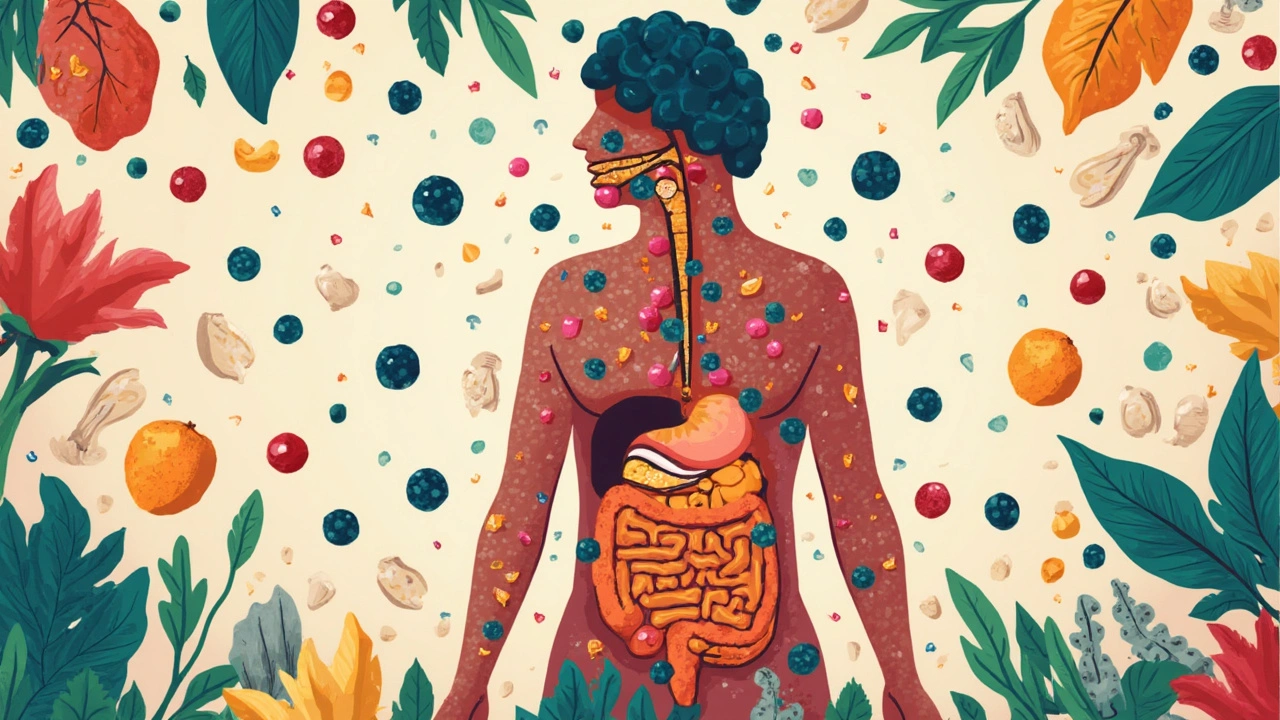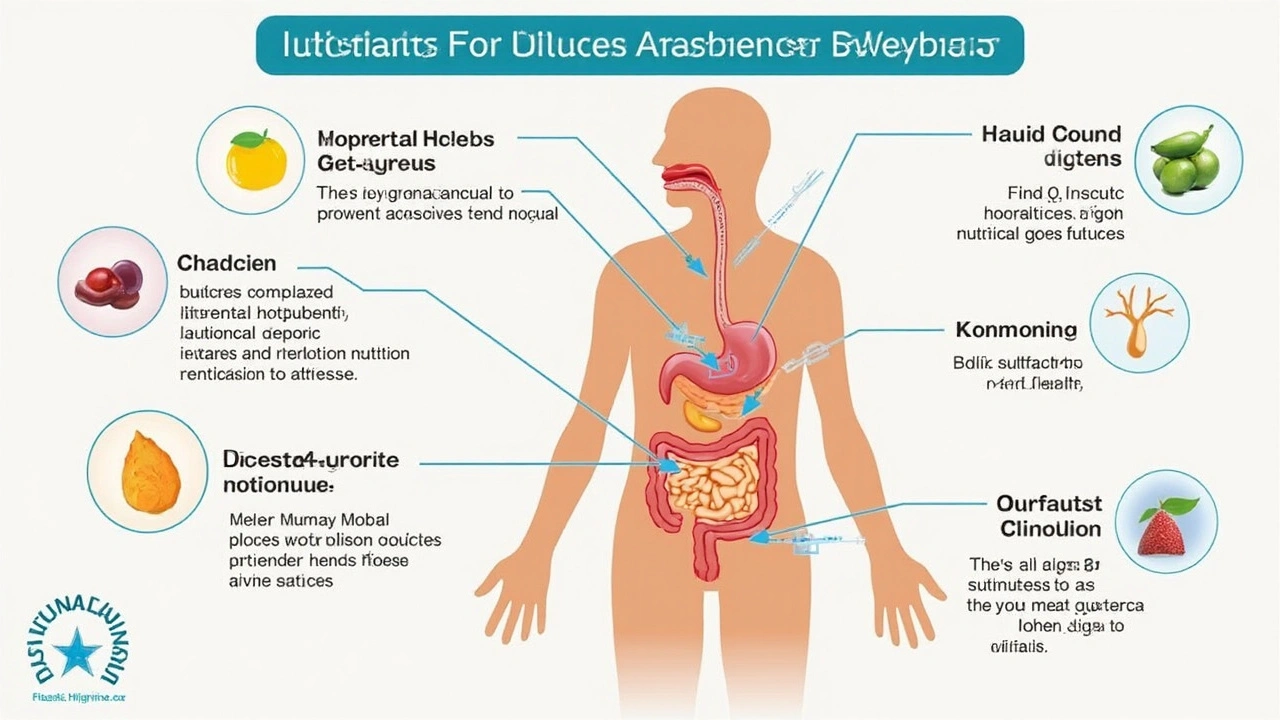Antioxidants In Managing Atrophic Gastroenteritis: What You Need To Know
 Feb, 3 2025
Feb, 3 2025
Atrophic gastroenteritis sounds pretty intense, doesn’t it? It's a condition where the lining of your stomach gets thinner and less effective at doing its job, which can mess with how you digest and absorb nutrients. Imagine your stomach lining as your favorite sweater that’s been through the wash too many times—it’s not as warm or comfortable anymore.
But here’s where the superheroes of the story come in—antioxidants. These are tiny fighters found in some foods that help protect our cells from damage. We’re talking blueberries, spinach, dark chocolate, and other tasty favorites. Antioxidants might just have the extra punch needed to support those with atrophic gastroenteritis.
So, what can these powerful little nutrients do? They're known to help reduce inflammation and repair cell damage—exactly the kind of help your gut might appreciate. By sneaking more antioxidants into your diet, you might be giving your digestion a bit of a fighting chance. Curious yet? Learning about which foods pack the most antioxidant punch could be your next kitchen adventure.
- Understanding Atrophic Gastroenteritis
- What Are Antioxidants?
- How Antioxidants Help
- Food Sources of Antioxidants
- Tips for Incorporating Antioxidants
Understanding Atrophic Gastroenteritis
Alright, let’s break this down. Atrophic gastroenteritis is basically when the lining of your stomach becomes a bit too thin and fragile. Think of your stomach lining as the factory that processes all the food you eat. If it's not working properly, you could run into some issues, like poor digestion or even nutrient deficiencies.
This condition isn't super rare either. It usually pops up in older adults, but anyone could potentially face it. Sometimes, it’s linked to other conditions like chronic gastritis, which could be due to an infection like H. pylori bacteria, or autoimmune problems. And yes, it’s quite possible that your favorite spicy foods or a tad too much alcohol over the years could be culprits too.
Common Symptoms to Watch For
So, what exactly are the signs? Well, if you're constantly feeling bloated, having tummy pains, or noticing unexplained weight loss, these could be red flags pointing to problems in the gut. Even things like fatigue or weakness can sneak in because, believe it or not, your digestion affects your whole body.
Diagnosis and Management
You're probably wondering how doctors figure this out. Typically, you'd be looking at endoscopies—yep, those camera-down-the-throat situations—to check out the status of your stomach lining. They might run a few blood tests too, just to be sure nothing else is at play.
- Stay away from overly spicy or acidic foods.
- Balance is key—try eating smaller, more frequent meals.
- Stay hydrated but avoid drinking too much during meals.
- Make sure you're getting enough vitamin B12.
Managing atrophic gastroenteritis involves lifestyle tweaks and diet changes, and antioxidants might just be the companions you need on this journey. Stick around to find out how they fit into the picture!
What Are Antioxidants?
Let's break down this buzzword: antioxidants. These are like the body’s little defense agents, helping to fend off free radicals. Free radicals? They're not as cool as they sound. They're unstable molecules that can cause havoc, damaging cells and leading to pesky things like inflammation and even diseases.
The magic of antioxidants is in their ability to stabilize these troublemaking free radicals, preventing them from causing further damage. Think of it like a buddy who’s always there to have your back in a jam.
Types of Antioxidants
Antioxidants aren't just one thing. They're a family, with each one bringing something unique to the table. Here are some of the big hitters:
- Vitamin C: Known for boosting the immune system, it’s also a terrific antioxidant found in citrus fruits, strawberries, and bell peppers.
- Vitamin E: This one's great for your skin and can be found in nuts, seeds, and green leafy veggies.
- Beta-carotene: Part of the vitamin A family, often found in carrots, sweet potatoes, and pumpkins.
- Selenium: Although a mineral, it acts as an antioxidant too and is present in Brazil nuts, fish, and grains.
So, why does all this matter for someone dealing with atrophic gastroenteritis? A healthier stomach lining means better digestion, and these antioxidant-rich foods can help restore and maintain that lining. Including a variety of these in your diet isn’t just good for the gut; it’s a boost for your overall health.

How Antioxidants Help
Alright, so let’s get into how these antioxidants actually make a difference when dealing with atrophic gastroenteritis. The body is constantly under attack from something called oxidative stress. This is when harmful molecules, known as free radicals, start making a mess of our cells, including those crucial to our digestive health.
Fighting Inflammation
One of the biggest benefits of antioxidants is their anti-inflammatory properties. When you have atrophic gastroenteritis, inflammation in your gut can become a daily enemy. Antioxidants like vitamin C, vitamin E, and beta-carotene come to the rescue by helping to reduce this inflammation, making your digestive system a bit happier and more cooperative.
Repairing Cellular Damage
Antioxidants also play a key role in repairing cells that have been damaged by free radicals. Think of them as your body’s repair crew, fixing up the wreckage in your stomach lining so it can function better. This means more efficient nutrient absorption and less stomach distress overall.
Supporting the Immune System
Your gut plays a huge part in maintaining a strong immune system. By managing oxidative stress, antioxidants help bolster immune responses, which is especially important when dealing with chronic conditions like atrophic gastroenteritis. A stronger immune system means less illness and more vibrant health.
Here's a quick look at how some specific antioxidants work:
- Vitamin C: Found in citrus fruits and bell peppers, it helps neutralize free radicals and supports the immune system.
- Vitamin E: Present in nuts and seeds, it protects cell membranes from oxidative damage.
- Beta-Carotene: Found in carrots and sweet potatoes, it converts to vitamin A, essential for immune function.
By increasing your intake of these antioxidants, you could see improvements in how your body handles the challenges of atrophic gastroenteritis. It's like giving your gut a little extra armor against daily stresses!
Food Sources of Antioxidants
When it comes to loading up on antioxidants, your grocery list can be your best friend. These aren't just ordinary groceries; think of them as gut protectors. So, what do you put in your cart?
Fruits and Berries
The fruit aisle is a jackpot for antioxidants. Berries are some of the richest sources. Blueberries, strawberries, and raspberries not only taste good but are packed with these vital nutrients. Don't skip the apples and plums, either, as they throw a mean antioxidizing punch too.
Veggie Power
Don’t underestimate the power of greens. Spinach, kale, and broccoli are top-notch when it comes to antioxidants. Toss them in a salad or blend them into smoothies—getting creative here is totally allowed!
Nuts and Seeds
Now, onto nuts and seeds. Almonds and walnuts are not just crunchy snacks; they hold a high antioxidant value. Flaxseeds also join this gang offering omega-3 and antioxidant benefits.
- Almonds - for that quick healthy munch
- Walnuts - perfect for sprinkling on your breakfast yogurt
- Flaxseeds - the best smoothie booster
Chocolate, Yes You Heard Right!
If you’re into chocolate, we’ve got good news. Dark chocolate contains more antioxidants than many fruits. Just be mindful of the sugar content if you're making this your daily nibble.
| Food | Antioxidant Content |
|---|---|
| Blueberries | 9.2 mmol/100g |
| Dark Chocolate | 15 mmol/100g |
| Spinach | 0.9 mmol/100g |
It’s clear that with the right foods, you can feed your gut the help it needs to manage something like atrophic gastroenteritis. Start small, keep it simple, and before you know it, your diet is a powerhouse of good-for-you foods.

Tips for Incorporating Antioxidants
Alright, so you're on board with loading up on antioxidants to help manage atrophic gastroenteritis. But where do you start? Here are some hands-on tips that can easily fit into your day-to-day life.
Make Breakfast Count
Kick-start your morning with a colorful smoothie or oatmeal topped with fruits like blueberries and strawberries. These berries are nature's antioxidant powerhouses. Toss in a handful of spinach or kale if you’re feeling adventurous.
Snack Smart
Swap those chips and cookies for raw nuts or dark chocolate. Nuts like almonds and walnuts are packed with healthy fats and antioxidants. And chocolate? Yes, as long as it’s dark (70% cocoa or more). It’s a tasty way to sneak in some digestive health benefits.
Revamp Your Meals
Next time you’re whipping up pasta or roasting veggies, sprinkle a little extra turmeric or ginger. These spices not only add flavor but are also rich in antioxidants. Try incorporating a side salad with colored veggies like red bell peppers and carrots.
DIY Drinks
Trade sugary drinks for a cup of green tea or a palatable herbal option like ginger tea. Both boast impressive levels of antioxidants. Easy to prepare, these teas make great daily habits.
Consistency is Key
Keep in mind, it’s about what you do consistently, not just occasionally. Gradual changes in the diet can lead to lasting improvements in your gut health over time. Start with one swap a week and build from there.
Gathering all these superhero foods might seem like a lot at first. But once you start, you’ll find it’s not as tricky as you thought. And hopefully, your tummy will love you for it.

stephen riyo
February 7, 2025 AT 16:00So you're telling me I can eat chocolate and call it medicine?? I mean, I'm not complaining, but is this backed by science or just wishful thinking??
Wendy Edwards
February 8, 2025 AT 22:18OMG YES I LOVE THIS!! I’ve been eating blueberries every morning and my bloating has gotten WAY better. I didn’t even connect it to antioxidants until now. My gut is basically throwing a party now 🎉💙
Jaspreet Kaur
February 10, 2025 AT 04:24Antioxidants are just nature's way of whispering to your cells to calm down and breathe. The stomach doesn't need fighting it needs understanding. Food isn't medicine it's conversation
Gina Banh
February 11, 2025 AT 02:01Blueberries have 9.2 mmol/100g? That's barely a drop. Dark chocolate at 15? Sure, but you'd need to eat 50g daily to match a single antioxidant supplement. Don't get fooled by marketing. Real healing needs clinical doses.
Deirdre Wilson
February 12, 2025 AT 03:52I always thought antioxidants were like little superheroes in my smoothie cape. Now I know they're more like quiet librarians keeping the chaos of my stomach in order. Still cool.
Damon Stangherlin
February 12, 2025 AT 14:00This is such a helpful breakdown. I’ve been avoiding spinach because I thought it made my stomach worse, but maybe I just needed to cook it differently. Gonna try blending it into a smoothie this week!
Ryan C
February 13, 2025 AT 12:14Actually, the ORAC scale (Oxygen Radical Absorbance Capacity) was deprecated by the USDA in 2012 because it doesn't correlate with in vivo bioavailability. So those numbers on the table? Meaningless. 🤦♂️
Dan Rua
February 15, 2025 AT 01:35Love this post! I've been doing the dark chocolate + almond snack thing for a month now and honestly? My acid reflux is way better. Not cured, but way more manageable. Small wins!
Mqondisi Gumede
February 15, 2025 AT 02:47You Americans think food fixes everything. In South Africa we know real healing comes from ancestral herbs and sweat not blueberries and chocolate. This is colonized nutrition
Douglas Fisher
February 15, 2025 AT 19:54Wait, wait, wait - you mentioned H. pylori? Did you test for it? Because if you have atrophic gastritis and you haven’t been tested for H. pylori, you’re missing the root cause entirely. Seriously. Get tested.
Albert Guasch
February 16, 2025 AT 17:25While the consumption of dietary antioxidants may exert a modulatory effect on oxidative stress markers in the gastrointestinal mucosa, the clinical efficacy remains inconclusive due to heterogeneity in study populations, dosing regimens, and methodological limitations. Further randomized controlled trials are warranted.
Ginger Henderson
February 17, 2025 AT 11:29So you're saying I can eat more chocolate and call it 'gut healing'? I'm in. But also, who wrote this? It sounds like a marketing brochure for a juice bar.
Bethany Buckley
February 17, 2025 AT 14:01How quaint. Antioxidants? As if free radicals are the villain and blueberries the knight in shining armor. The real issue is epigenetic dysregulation and mitochondrial dysfunction - but I suppose for the masses, a berry smoothie is easier to digest than complexity.
Stephanie Deschenes
February 18, 2025 AT 05:19I’ve been working with patients with atrophic gastritis for 12 years. Antioxidants help, but only as part of a full protocol - B12 injections, stomach acid support, and eliminating trigger foods. Don’t skip the basics.
Cynthia Boen
February 18, 2025 AT 10:18This whole post is just a bunch of feel-good nonsense. You think eating spinach fixes atrophic gastritis? Go ask someone with stage 3 intestinal metaplasia if their blueberries helped. Spoiler: they didn't.
Amanda Meyer
February 20, 2025 AT 04:36Interesting perspective - but what about the role of gut microbiota in modulating antioxidant absorption? The efficacy of dietary antioxidants might be entirely dependent on individual microbiome composition. We’re missing the bigger picture here.